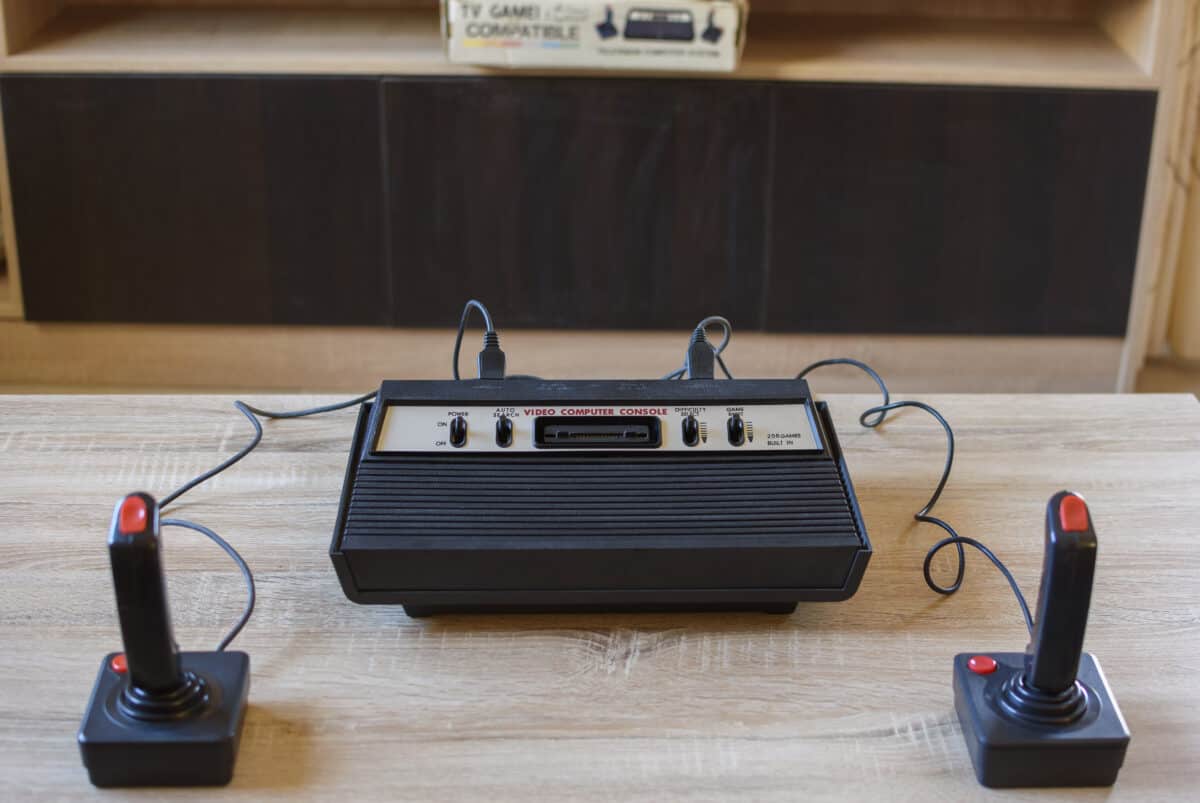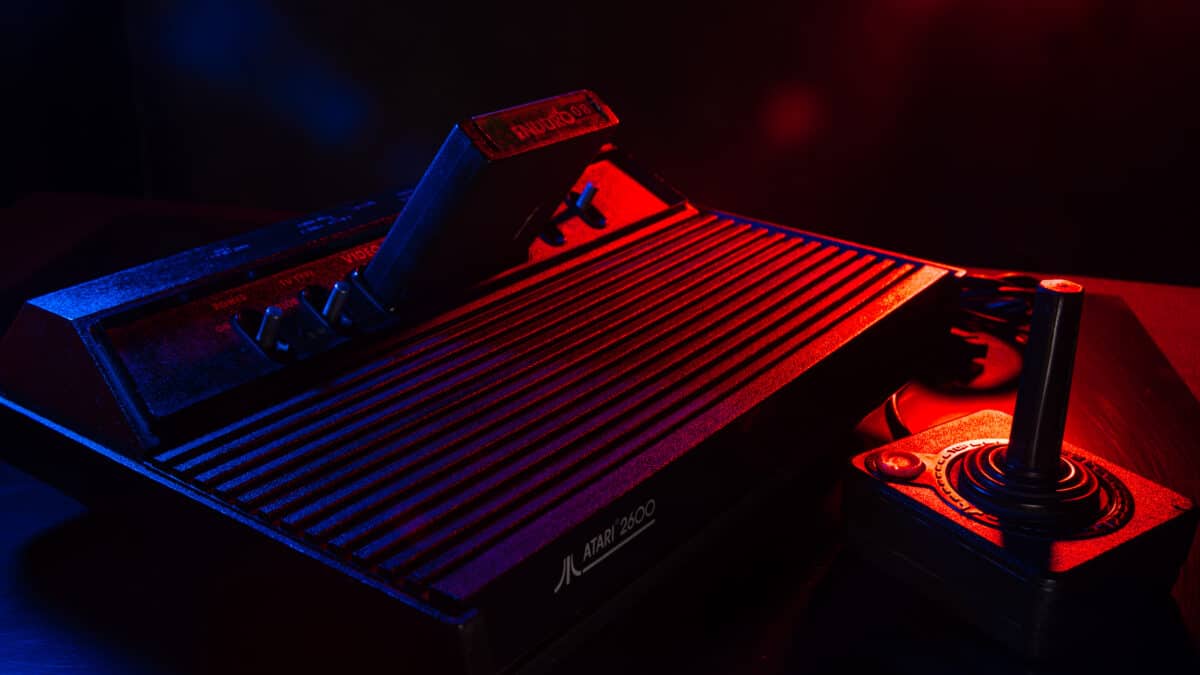Atari is a popular platform amongst retro gamers who enjoy the simpler things in life. The Atari 2600, initially branded as the Atari Video Computer System (Atari VCS,) was a staple of many gamers’ childhoods. So those gamers were sad to see the platform wither into obscurity. Few people know why the Atari platform dissolved, but some theories exist.
Most game industry people feel Atari’s failure can be attributed to their excessive and unregulated support for third-party developers, leading to an oversupply of terrible Atari games. But it can also be attributed to the global video game industry crash that occurred during Atari’s lifespan.
6 Facts About Atari
- Many people consider the founders of Atari to be the fathers of video games.
- Atari was founded in 1972 with an investment of $250.
- Within years, Atari would be worth over 2 billion dollars.
- The first Pong prototype arcade cabinet used a coin slot from a laundromat machine.
- The first Pong prototype was so successful that the cabinet began to malfunction from the coin collector overflowing.
- The company name comes from the Japanese word “atari” which means “hit,” “strike,” or “to be correct,” and is the Japanese name for the game Go.
Atari’s History
Humble Beginnings: The Beginning of Western Video Game Development
Atari began in 1972 when Nolan Bushnell and Ted Dabney founded the company. The company was started with $250 in investments, which amounts to about $1500 today—nowhere near as much as what is typically needed to start a business now, but a lot for the time.
Atari’s first project was a prototype arcade machine that allowed players to play games of Pong. The system used a coin loader repurposed from a laundromat-style laundry machine. Unfortunately, the coin catcher they used in this prototype was a milk carton, proving insufficient for the device’s popularity.
The first Pong arcade machine was installed at Andy Capp’s tavern. The device was wildly popular. So much so that the milk carton used to collect the coins for each play began to overflow, causing the machine to malfunction, an issue quickly caught by patrons who just wanted to play another game.
Kee Games: the First Competitor
In 1973, a direct competitor, Kee Games, was founded by Joe Keenan, Nolan Bushnell’s next-door neighbor. Kee Games would be a short-lived but influential passion project that would result in Keenan’s promotion to president of Atari.
Kee Games focused on nipping the problem of exclusivity deals in gaming in the bud. Prior to Kee Games’ introduction to the market, both Kee and Atari could pitch and market nearly identical games to investors, and both may achieve exclusivity deals.
Keenan focused on making games more unique and pushed for a move away from exclusivity deals which could water down the market with platform-exclusive clones of the same games.
Home Consoles: a New Market

©Pit Stock/Shutterstock.com
The next great frontier for Atari was bringing games into the house on a home console. Thus, the Atari Entertain System was born. This system was capable of reading cartridges, allowing it to play Atari’s four games at home, connected to a TV.
The introductory MSRP for the system was $199, equivalent to almost USD 1000 today. It came with the system, joystick, paddles, and a copy of Atari’s Combat game. At this point, Atari had become a household name.
Bushnell knew he had another hit up his sleeve and began looking to outside investors to fund the expensive project he had in mind. Bushnell sold the company to Warner Communications in 1979, intending to use the funds to produce his next game.
Atari VS Warner Communications
However, Warner and Bushnell were often at odds in producing new IPs and systems. In particular, Warner wanted to discontinue the renamed Atari 2600 and focus on the more recent, fancier Atari 5200. Bushnell wanted to continue production for the Atari 2600, culminating in a massive argument between Bushnell and Manny Gerard, a member of the Office of the President at Warner Communications. This argument would be where Bushnell and Atari finally parted ways, just after the dissolution of Kee Games in 1978.
By 1983, the Video Game Crash of 1983 would take Atari underwater with it, and Atari would shift to building home computers as a stopgap method to keep itself above water.
The Video Game Crash of 1983—Atari Shock
What Is Atari Shock?
The Video Game Crash of 1983 was a large-scale recession that occurred in the 1980s video game industry. It primarily affected the United States market and is known as Atari Shock in Japan. The exact reason for the crash is hotly debated, but most experts attribute the crash to market saturation, a high number of game consoles and games that were largely poor quality, and a growing interest in personal computers.
In 1983, revenue from western video games reached a peak of $3.2 billion dollars which would crash to just $100 million by 1985. The crash destroyed the burgeoning market in the United States, causing the bankruptcy of several major market contenders, including Atari.

In the early 1980s, Atari released a series of games for their popular console that are now considered to be some of the best games in that genre.
©Milton Buzon/Shutterstock.com
Why Did Atari Shock Happen?
The crash had many factors that led up to it. One major factor was the flooded market of home consoles that followed the boom led by Atari. After Atari’s success in both the arcade and home console markets, the market was flooded with cheap clones looking to ride the coattails of Atari. These clones and the games they played were largely of poor quality and severely damaged the name of both Atari and their proprietary companies.
Additionally, these clones were accompanied by the first third-party developers. While the first few studios, like Activision, were pursuits of love for the burgeoning platform, their success attracted venture capitalists who wanted to mirror the success of Activision without the hard work and audience-level knowledge of the platform.
These venture capitalists produced games that bombed time after time and damaged the public perception of video games and their parent companies, like Atari. Garbage knock-offs soon littered the shelves and experts predicted that just 10% of games would account for 75% of sales.
This boom polluted the industry and led to a negative stigma and poor public perception of the video games industry. This coupled with the increased public interest in personal computer ownership led to the crash.
Public Perception of Atari
Finally, Atari’s publishing had lost consumer confidence. The home port of the arcade game Pac-Man was a major flop. The graphics of the game were cited as being particularly poorly done and despite the seven million copies sold, many consumers found the game so intolerable that they pursued refunds.
Following that was the release of E.T. the Extra-Terrestrial which was developed in six weeks by a single person, Howard Scott Warshaw. The game was rushed to meet sales for the Christmas deadline and was, to put it politely, a huge disaster.
The combined failures of Pac-Man and E.T. the Extra-Terrestrial damaged Atari’s brand beyond recognition and led to the crash in 1983.
Historical Significance of Atari
Atari was considered to be the father company of all gaming. Atari was responsible for developing the West’s first arcade machines and home consoles. However, the company’s existence as a video game mega-giant was extremely short-lived.
Atari’s vision was later carried out and continued by Nintendo which marketed the Famicom console as the Nintendo Entertainment System (NES.) Nintendo was determined not to make the mistakes that led to Atari’s dissolution and their bid went well, bringing the video game market in America back to life.
A rumor also spawned that millions of unsold copies of E.T. the Extra-Terrestrial were buried in a landfill in New Mexico. The rumor was based on the true event in which Atari discreetly buried excess stock in a landfill. Gaming historians sought permission to dig up the landfill and found that the number of cartridges buried had been inflated by myth and was only around 800,000—still a monumental amount of excess stock to be destroyed.
After Atari’s ventures continued to produce flop after flop, the company was sold to Jack Tramiel who focused Atari on developing personal computers, namely the Atari ST.
Final Thoughts
Atari’s time has come and gone. Some were sad to see it go and others were waiting for it to happen. However, the games are kept alive by video game historians who lovingly document the progress of the industry from start to finish.
Up Next
- The 5 Real Reasons Polaroid Failed
- The Real Reason Nokia Failed Spectacularly
- The Real Reason LaserDisc Failed Spectacularly